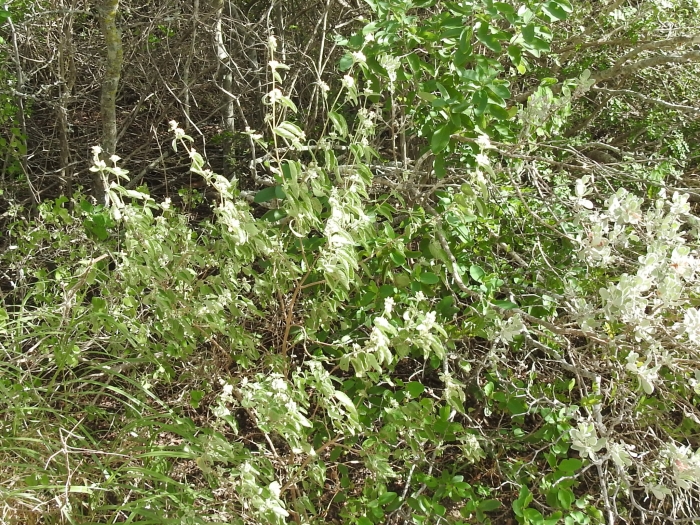Mexican Oregano
(Lippia origanoides)
Mexican Oregano (Lippia origanoides)
/
/

Sam Kieschnick
CC BY 4.0
Image By:
Sam Kieschnick
Recorded By:
Copyright:
CC BY 4.0
Copyright Notice:
Photo by: Sam Kieschnick | License Type: CC BY 4.0 | License URL: http://creativecommons.org/licenses/by/4.0/ | Rights Holder: Sam Kieschnick | Publisher: iNaturalist | Date Created: 2019-09-29T17:01:09-07:00 |
































Estimated Native Range
Summary
Lippia origanoides, commonly known as Mexican Oregano, is an evergreen shrub native to a variety of habitats including tropical deciduous forests, thorn scrub, and dry slopes in Mexico, Central and South America, as well as the Caribbean. It belongs to the Verbenaceae family and is not closely related to true oregano. This versatile plant typically reaches 1–2.7 m (3.3–8.9 ft) in height and is known for its aromatic leaves and small, tubular white or yellowish flowers that bloom throughout the year, particularly after rainfall, adding a modest ornamental value.
Mexican Oregano is valued for its culinary uses, as its leaves impart a flavor reminiscent of true oregano and are widely used in Mexican and Central American cuisine. It is also appreciated for its ease of maintenance and drought tolerance, making it suitable for xeriscaping. In cultivation, it thrives in full sun and requires low to medium water, adapting well to soils with medium to fast drainage. While it is primarily grown for its flavorful leaves, it can also serve as an informal hedge or accent plant in a garden. Care should be taken as it can become invasive in some regions, spreading through root suckers and seed dispersal.CC BY-SA 4.0
Mexican Oregano is valued for its culinary uses, as its leaves impart a flavor reminiscent of true oregano and are widely used in Mexican and Central American cuisine. It is also appreciated for its ease of maintenance and drought tolerance, making it suitable for xeriscaping. In cultivation, it thrives in full sun and requires low to medium water, adapting well to soils with medium to fast drainage. While it is primarily grown for its flavorful leaves, it can also serve as an informal hedge or accent plant in a garden. Care should be taken as it can become invasive in some regions, spreading through root suckers and seed dispersal.CC BY-SA 4.0
Plant Description
- Plant Type: Shrub
- Height: 3-5 feet
- Width: 2-3 feet
- Growth Rate: Rapid
- Flower Color: White
- Flowering Season: Spring, Summer
- Leaf Retention: Evergreen
Growth Requirements
- Sun: Full Sun
- Water: Low, Medium
- Drainage: Medium, Fast
Common Uses
Bee Garden, Butterfly Garden, Edible*Disclaimer: Easyscape's listed plant edibility is for informational use. Always verify the safety and proper identification of any plant before consumption., Fragrant, Groundcover, Low Maintenance, Street Planting
Natural Habitat
native to a variety of habitats including tropical deciduous forests, thorn scrub, and dry slopes in Mexico, Central and South America, as well as the Caribbean
Other Names
Common Names: Salva-De-Marajó
Scientific Names: , Lippia graveolens, Lippia origanoides, Lippia sidoides, Lippia microphylla, Lippia palmeri, Lippia elegans, Lippia salviifolia, Lippia glandulosa, Lippia obscura
GBIF Accepted Name: Lippia origanoides Kunth